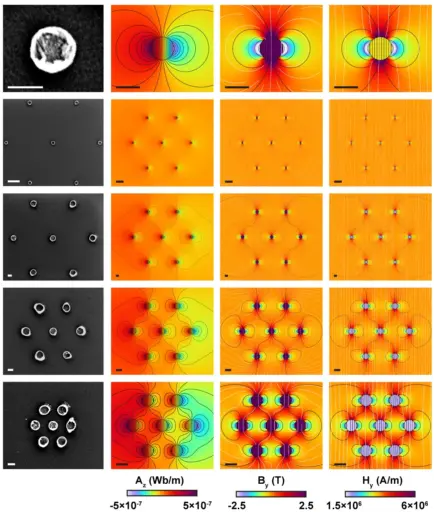It started out as a side project, a repurposing of the nanopatterning techniques that Ilhan Bok has fashioned in Assistant Professor Aviad Hai’s neuroengineering lab at the University of Wisconsin-Madison.
Bok, a PhD student in the Department of Biomedical Engineering, and Hai were curious: Could they use their nanofabricated particles to experimentally test longstanding computational theory about how particle clustering, size and geometry affects signaling in magnetic resonance imaging (MRI)?
“We discovered that we were doing something that hasn’t been done before,” says Hai.
Their efforts paid off. Hai and Bok, with help of lab mate Alireza Ashtiani (PhDEE ’16), an assistant scientist, and Beth Rauch, an instrumentation specialist in the Department of Medical Physics, were able to validate computational simulations that date to the early 1990s.
They published their results in the journal Magnetic Resonance in Medicine, which flagged the paper as a “rapid communication,” signifying its importance for the field.
“This is something really basic that a lot of this science relies on, but no one really went as far as just to test this exact effect,” says Bok (BSCmpE ’20), a Madison native whose research focuses on creating nanoparticles for imaging technologies such as magnetic particle imaging.
 A figure from the paper shows the range of magnetic fields in proximity to nanoparticle clusters of different orientations. Image courtesy Hai lab.
A figure from the paper shows the range of magnetic fields in proximity to nanoparticle clusters of different orientations. Image courtesy Hai lab.
By using innovative nanolithography techniques, Bok produced arrays of iron oxide nanoparticles with a variety of geometries, allowing the group to prove the nonlinear relationship between the size of an aggregation of nanoparticles and the MRI signal strength. Nanoparticles are frequently used as contrast agents with MRI to enhance the signal.
Hai says the project forms a basis for developing any type of MRI sensor that relies on aggregation of particles. “It can be used to develop new types of sensors and know exactly how they’re going to operate,” he says. “We can understand what the MRI signal would be as a result of the particle size used, their distance, how they aggregate, etc. It turned out to be a really important study.”
The researchers are making their code available online to allow other labs to reproduce their results and use them to inform the design of new sensors. (Visit the Hai lab’s main GitHub page for other projects, too.)
Aviad Hai is a Vilas Early Career Assistant Professor, part of the Wisconsin Institute for Translational Neuroengineering and an affiliate of the Department of Electrical and Computer Engineering. Funding for this research came from the National Institute of Neurological Disorders and Stroke and the Office of the Director’s Common Fund at the National Institutes of Health via grant DP2NS122605 and the National Institute of Biomedical Imaging and Bioengineering via grant K01EB027184. Additional support came from the US Office of Naval Research under award numbers N00014-23–1-2006 and N00014-22–1-2371 and the Wisconsin Alumni Research Foundation (WARF).